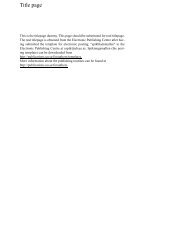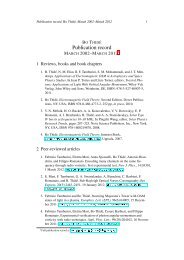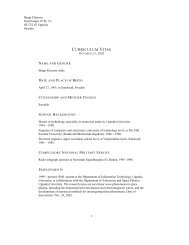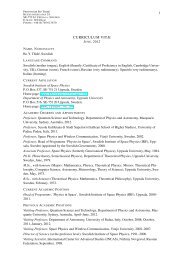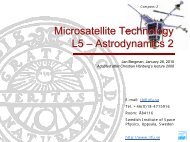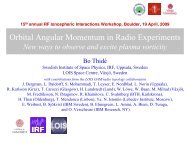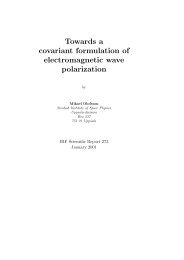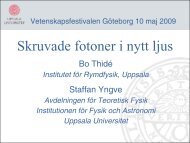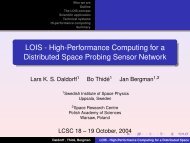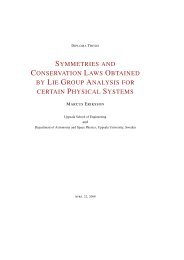Atmosphere-Ionosphere Mission - Swedish Institute of Space ...
Atmosphere-Ionosphere Mission - Swedish Institute of Space ...
Atmosphere-Ionosphere Mission - Swedish Institute of Space ...
Create successful ePaper yourself
Turn your PDF publications into a flip-book with our unique Google optimized e-Paper software.
TECHNOLOGY 14<br />
The first positive band <strong>of</strong> N 2 is the dominant optical emission <strong>of</strong> sprites that<br />
occur in the altitude range around 70 km. An optical recorder that could detect this<br />
band would be able to record the occurrence <strong>of</strong> sprites in space and time around<br />
the globe. This information could be coupled with the ground based lightning<br />
detection systems to evaluate, not only the number <strong>of</strong> sprites that are created in the<br />
upper atmosphere per second, but also the conditions under which these lightning<br />
flashes are created.<br />
2.3 Modelling<br />
Satellite-based mobile multimedia networks are expected to play a significant role<br />
in next generation mobile communication systems and an integral and essential<br />
part <strong>of</strong> the global multimedia infrastructure. This is because they can provide<br />
cost effective access to the global multimedia infrastructure in areas where their<br />
terrestrial counterparts require high cost and, in general, inefficient utilisation. Deploying<br />
satellite mobile multimedia networks in these areas and integrating them<br />
with the terrestrial mobile infrastructure, mobile multimedia services could be<br />
<strong>of</strong>fered seamlessly worldwide. For the above reason, it is important to investigate<br />
the performance <strong>of</strong> these systems and to engineer appropriate solutions capable <strong>of</strong><br />
providing multimedia services characterized by high transmission rates and better<br />
quality <strong>of</strong> services (QoS). In this context, a number <strong>of</strong> different satellite configurations<br />
will be considered.<br />
The AIM satellites will, together with the planned LOIS infrastructure, provide<br />
a ground-space infrastructure which can be used to model and test ideas for new<br />
methods <strong>of</strong> satellite communications, in particular multiple-input, multiple-output<br />
(MIMO) techniques [22].<br />
The Department <strong>of</strong> Scientific Computing at Uppsala University has a well established<br />
high competence in using and developing numerical methods for the solution<br />
<strong>of</strong> partial differential equations typical for the type <strong>of</strong> physical problems to be<br />
studied in the AIM mission such as flow problems, electromagnetic radiation and<br />
wave propagation [6, 7, 8, 9, 10, 12, 21]. A new parallel computer with 48 processors<br />
has recently been installed and a PC cluster is available at the department.<br />
These computing resources will be used to model both the turbulence and radiation<br />
physics and the electromagnetic properties <strong>of</strong> the AIM platform and antennas. In<br />
an ongoing project in cooperation with the <strong>Institute</strong> <strong>of</strong> <strong>Space</strong> Physics, the nonlinear<br />
interactions between particles and electromagnetic radiation in a magnetised<br />
plasma are modelled by the Maxwell-Vlasov equations. The equations are solved<br />
accurately in large scale simulations on these machines.<br />
3 Technology<br />
The mission with its requirements for smart and small payloads and spacecraft is<br />
important for advanced technology development and <strong>of</strong> express interest to industry.<br />
The same can be said about the low orbit and high data transfer rates required. The<br />
<strong>Atmosphere</strong>-<strong>Ionosphere</strong> <strong>Mission</strong><br />
Elaborate Science Case



